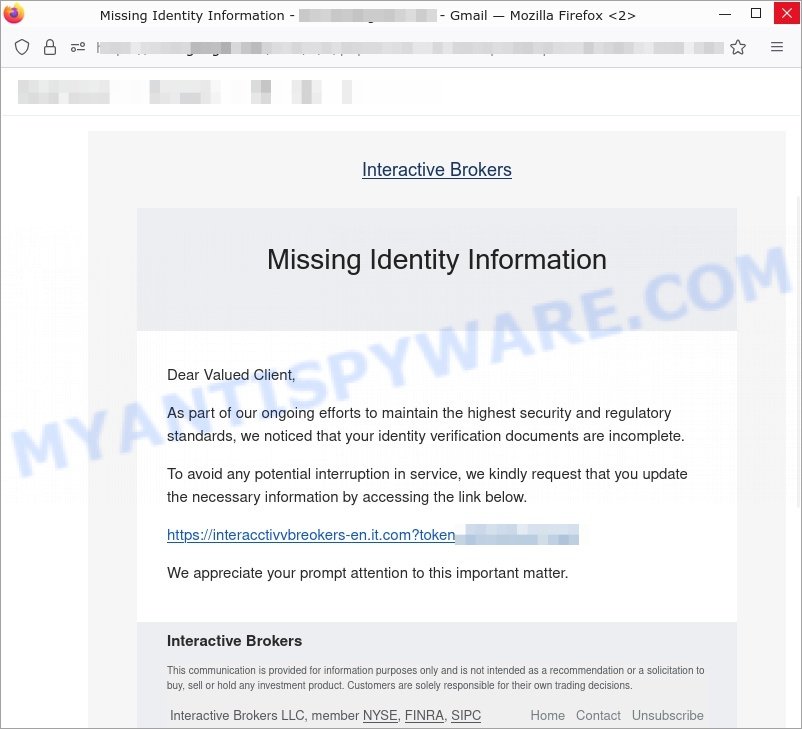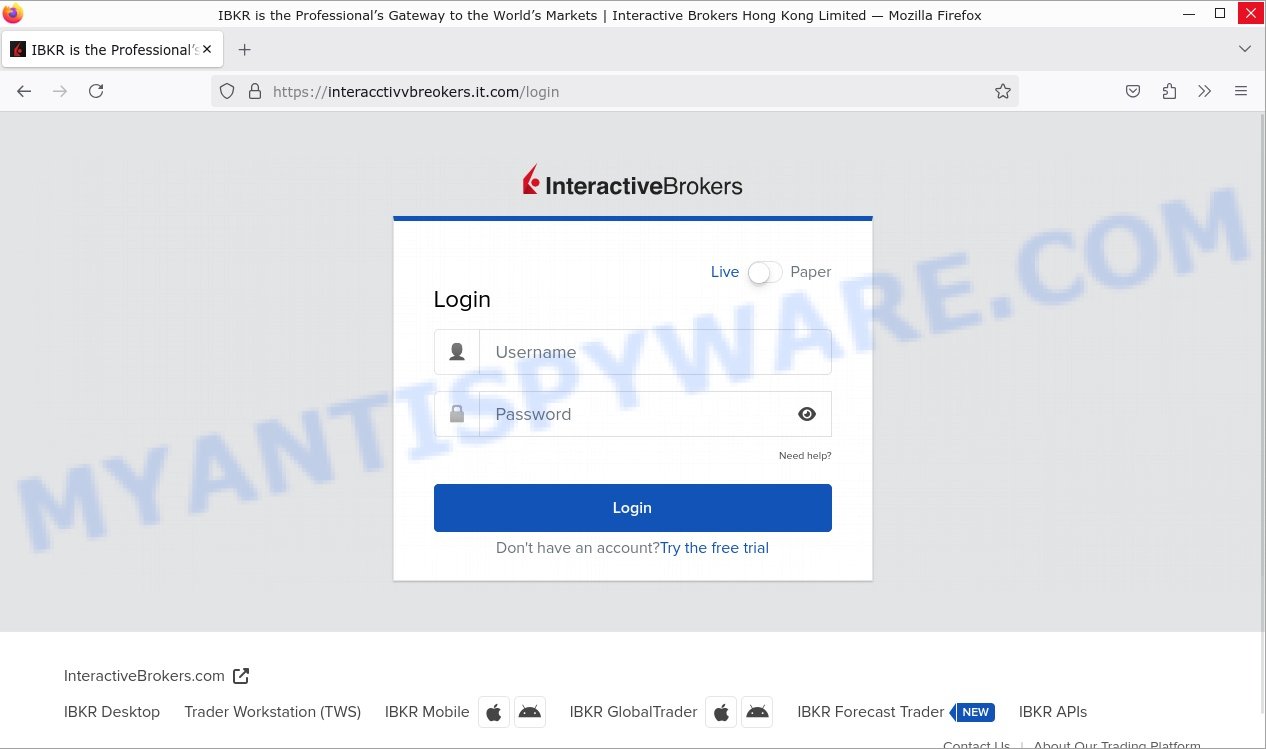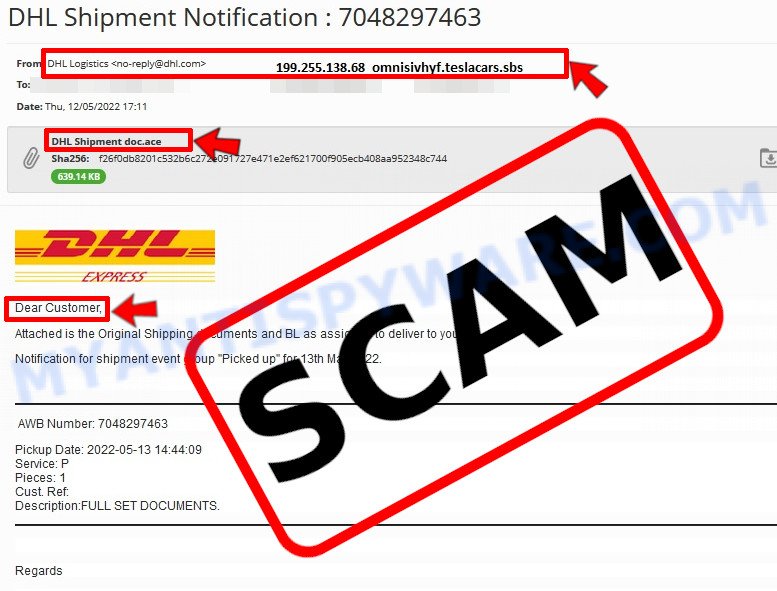Have you received an email claiming to be from Interactive Brokers, saying your identity information is missing and asking you to update your documents through a link?
Question: Is this email really from Interactive Brokers and is it safe to click the link and enter your login details?

Investigation Findings: The email comes from a suspicious address (banking@hwcegob.com) and includes a fake link that looks like an Interactive Brokers login page but is not the real website. Security tools have marked the link as suspicious.
Answer: This email is a fraudulent phishing attempt designed to steal your login information. 💡 To protect yourself from scams like this, never click links or enter passwords from unexpected emails. Always go directly to the official Interactive Brokers website by typing the address yourself. Additionally, check the sender’s email carefully and be cautious with messages asking for personal information.
A typical “Interactive Brokers Missing Identity Information” scam email reads as follows:
From: InteractiveBrokers banking@hwcegob.com
Subject: Missing Identity InformationInteractive Brokers
Missing Identity InformationDear Valued Client,
As part of our ongoing efforts to maintain the highest security and regulatory standards, we noticed that your identity verification documents are incomplete.
To avoid any potential interruption in service, we kindly request that you update the necessary information by accessing the link below.
hxxps://interacctivvbreokers-en.it.com?token=xxxxxxx
We appreciate your prompt attention to this important matter.
Interactive Brokers
This communication is provided for information purposes only and is not intended as a recommendation or a solicitation to buy, sell or hold any investment product. Customers are solely responsible for their own trading decisions.
Interactive Brokers LLC, member NYSE, FINRA, SIPC Home Contact Unsubscribe
🚨 Is the “Interactive Brokers Missing Identity Information” Email a Scam?
The email claiming to be from Interactive Brokers about missing identity information is a phishing scam designed to steal your login credentials. Scammers use this tactic to trick recipients into providing sensitive information by mimicking legitimate financial institutions like Interactive Brokers.

Key Red Flags:
- 🌐 Suspicious Sender Email: The email comes from
banking@hwcegob.com, which is unrelated to Interactive Brokers and looks random, a common sign of phishing. - 🔗 Malicious Links: The link provided (
interacctivvbreokers-en.it.com?token=xxxxxxx) imitates the official site but contains misspellings and unusual domain extensions. VirusTotal and other security tools flag these URLs as suspicious. - ⚠️ Fake Login Page: The link leads to a fraudulent login page that closely resembles the legitimate Interactive Brokers login form, crafted to capture your username and password.
- 📧 Generic and Urgent Language: The message uses generic greetings (“Dear Valued Client”) and creates a false sense of urgency (“to avoid any potential interruption”) to pressure users into acting quickly without verifying authenticity.
- 🔒 Lack of Personalized Information: Legitimate financial institutions usually address customers by name or provide other personalized details. This email lacks such information.
- 🕵️♂️ Domain Discrepancies: Official Interactive Brokers domains end with
interactivebrokers.com. The suspicious domains differ significantly from the real one. - 📉 Poor Formatting and Typos: Misspellings like “interacctivvbreokers” and inconsistent capitalization indicate lack of professionalism typical in scam emails.
In summary, the “Missing Identity Information” email purportedly from Interactive Brokers is a phishing scam designed to steal your sensitive login credentials. Never click on suspicious links or provide personal information through unsolicited emails. Instead, always verify directly through official websites and contact customer support if you have concerns about your account.
📧 What to Do When You Receive the “Interactive Brokers Missing Identity Information” Scam Email
We advise everyone who receives this email to follow the simple steps below to protect yourself from potential scams:
- ❌ Do not believe this email.
- 🔒 NEVER share your personal information and login credentials.
- 📎 Do not open unverified email attachments.
- 🚫 If there’s a link in the scam email, do not click it.
- 🔍 Do not enter your login credentials before examining the URL.
- 📣 Report the scam email to the FTC at www.ftc.gov.
If you accidentally click a phishing link or button in the “Interactive Brokers Missing Identity Information” Email, suspect that your computer is infected with malware, or simply want to scan your computer for threats, use one of the free malware removal tools. Additionally, consider taking the following steps:
- 🔑 Change your passwords: Update passwords for your email, banking, and other important accounts.
- 🛡️ Enable two-factor authentication (2FA): Add an extra layer of security to your accounts.
- 📞 Contact your financial institutions: Inform them of any suspicious activity.
- 🔄 Monitor your accounts: Keep an eye on your bank statements and credit reports for any unusual activity.
🔍 How to Spot a Phishing Email
Phishing emails often share common characteristics; they are designed to trick victims into clicking on a phishing link or opening a malicious attachment. By recognizing these signs, you can detect phishing emails and prevent identity theft:

💡 Here Are Some Ways to Recognize a Phishing Email
- ✉️ Inconsistencies in Email Addresses: The most obvious way to spot a scam email is by finding inconsistencies in email addresses and domain names. If the email claims to be from a reputable company, like Amazon or PayPal, but is sent from a public email domain such as “gmail.com”, it’s probably a scam.
- 🔠 Misspelled Domain Names: Look carefully for any subtle misspellings in the domain name, such as “arnazon.com” where the “m” is replaced by “rn,” or “paypa1.com,” where the “l” is replaced by “1.” These are common tricks used by scammers.
- 👋 Generic Greetings: If the email starts with a generic “Dear Customer”, “Dear Sir”, or “Dear Madam”, it may not be from your actual shopping site or bank.
- 🔗 Suspicious Links: If you suspect an email may be a scam, do not click on any links. Instead, hover over the link without clicking to see the actual URL in a small popup. This works for both image links and text links.
- 📎 Unexpected Attachments: Email attachments should always be verified before opening. Scan any attachments for viruses, especially if they have unfamiliar extensions or are commonly associated with malware (e.g., .zip, .exe, .scr).
- ⏰ Sense of Urgency: Creating a false sense of urgency is a common tactic in phishing emails. Be wary of emails that claim you must act immediately by calling, opening an attachment, or clicking a link.
- 📝 Spelling and Grammar Errors: Many phishing emails contain spelling mistakes or grammatical errors. Professional companies usually proofread their communications carefully.
- 🔒 Requests for Sensitive Information: Legitimate organizations typically do not ask for sensitive information (like passwords or Social Security numbers) via email.
Conclusion
The Interactive Brokers Missing Identity Information email is a phishing scam, designed to steal your personal login credentials through deceptive tactics. The scammers impersonate Interactive Brokers by sending realistic-looking emails with urgent warnings about incomplete identity verification, pressuring recipients to click on a malicious link.
Instead of a legitimate update request, the link directs you to a fake login page (hosted on suspicious domains like interacctivvbreokers-en.it.com) that closely mimics the official Interactive Brokers site. This fake site collects your username and password to compromise your account. Security services such as VirusTotal have flagged these domains as suspicious, confirming their malicious intent.
Bottom Line: Do not click on links or enter your information if you receive an unexpected email claiming to be from Interactive Brokers asking to update identity documents. Always verify the authenticity of such requests by contacting Interactive Brokers directly through their official website or customer service channels. Stay vigilant against phishing scams that use urgent language and forged email addresses to trick you into disclosing sensitive personal information.















